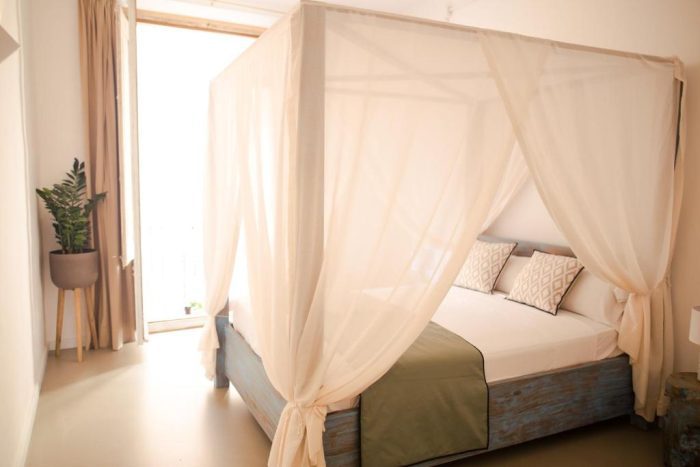If you live in an urban or suburban environment, there is a chance that you live near a cellphone tower. This indicates that the exposure to wireless pollution near your home is extremely high.
According to various biologists and healthcare professionals, the amount of wireless pollution we are exposed to can cause long-term damage to our health. So, one of the best things you can do in this case is to create an EMF protector in your home, especially where you sleep. Do you want to know how to install a canopy over a bed?
In our article today, we will share some valuable tips on how to install a canopy over a bed. This DIY project is straightforward and won’t cost you much, as the fabric is the most expensive part. Let’s get into the details.

How to Install a Canopy Over a Bed
Faraday canopies are both stylish-looking and effective anti-radioactive protectants. They look like a regular canopy, while their main effect is to create a shield around your bed as the electromagnetic exposure in this area in your home is the highest compared to the rest.
Regarding the fabric, I recommend going for either copper/nickel, metal mesh lined with cotton, silver fiber, or silver-coated nylon. Drill four holes on each side of the ceiling at a similar distance to your bed, then attach hooks into each hole.
Next, thread the curtain on a wire and tie the wire onto the hooks to hang the curtains around your bed, forming a square.
Step-By-Step Guide
Let’s face it, our bedroom is the most affected area of harmful EMF radiation, especially if you are someone that likes to use their smartphone before bed to watch TikTok or fall asleep with your TV on while watching your favorite show.
So, in this case, you must give your body a chance to rest and heal from the harmful radioactive energy.
One of the most effective things you can do is limit the usage of these devices. Building a Faraday canopy is another highly effective option if that is only partially possible. They are attractive looking and extremely functional in reducing radiofrequency due to their high resistance.
If you want to know how to install a canopy over a bed, follow the step-by-step instructions below:
Picking the right fabric
When assembling strong EMF shielding in your bedroom, first, you must pay special attention to the fabric for your canopy.
EMF shielding canopies are typically made of copper/nickel, metal mesh lined with cotton, silver fiber, and silver-coated nylon. These materials are excellent in blocking radiation and can be a perfect aesthetic addition for staying comfortable in your sleeping area.

Positioning the canopy
Before installing the canopy, you must ensure that there is enough space to cover the entire bed area from top to bottom for maximum radiation protection.
While installing the EMF shielding canopy, it’s important to place it a bit far away from the wall and the electrical outlets.
Install the hooks for the canopy
First, you must assemble the ceiling hooks to hold the fabric. Gluing the hooks on the ceiling is a good option if you don’t want to damage your wall, but if your canopy material is too dense, they might not be able to hold it, so drilling the hooks is far more secure.
Drill four holes in the ceiling with an approximate closeness to the four sides of your bed. Attach the hooks in the holes using a hammer and ensure they are tight enough to hold the weight without a problem.
Measure the distance from each hook
To determine the length of the fabric you’ll need for your canopy, you must know the exact distance between all four hooks so that you’ll be able to cover the entire bed area.
Depending on the measurements you’ve taken of the length between each hook, cut the curtain fabric into four pieces. You’ll also need four easily long pieces of wire for you to thread the curtain.
Hang the EMF protection fabric
Now tie each side of the curtain wire to the hooks on the ceiling by forming a loop. Secure them as tight as possible so that they don’t come loose or fall. Make sure all four pieces of curtains cover each side of the bed.
Another method is to use curtain hooks and attach them to the wire; it depends on which one is the easier and more economical option for you. Either way, the protective effect of the radiation will stay the same.
The Importance of Installing EMF Protecting Canopy Over a Bed
The truth is, it doesn’t matter if there is a high-frequency power line near your home; simply by possessing any electric appliance, you are exposed to the negative effects of the radio frequencies it emits one way or another.
As more inventions come out day by day, we cannot avoid not being freaked out by how much we are affected by the EMF they radiate and how it will affect the quality of our life.
When using EMF protective fabrics, you must know that not all are created equal, so if you are wondering whether investing in one is a smart choice, let me explain.
For maximum protection, you will need a fabric with at least 20dB protection from the overall EMF radioactive frequency to which you are exposed. This can refer to various things like radiation from electronics, including WiFi.
Fabrics with the highest EMF shielding performance
- Silver Net fabric offers the highest EMF protection for canopies worldwide, protecting about 51dB at 1GHz.
- When looking for fabrics with the highest shielding properties, check the labels and look for words like Naturell, Staticot, RadiaShield, and Silverell. These fabrics have an extremely high EMF shielding performance, which can bounce off about 99% EMF.
Conclusion
So, now that you have learned how to install a canopy over a bed, you can get one and do it. It is easy, and you will be protected from EMF radiation while sleeping.
Stay protected!
